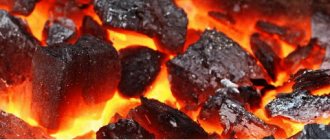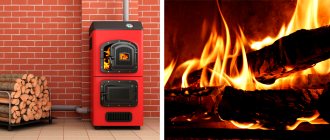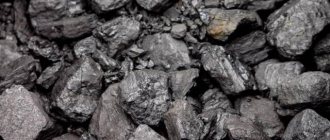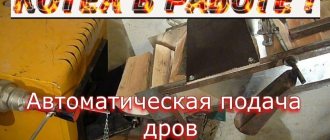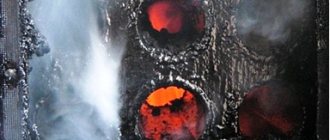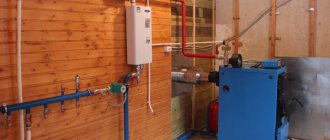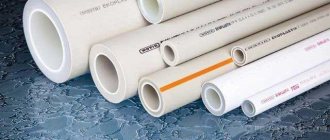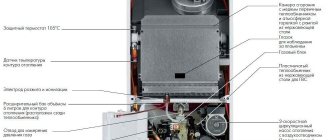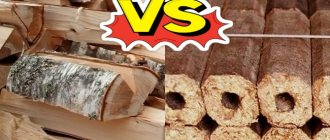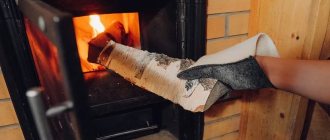Solid fuel boilers are a popular type of boiler equipment.
They are widely used for autonomous heating in facilities where it is not possible to use models running on natural gas.
Modern equipment of this class is capable of providing high-quality heating and at the same time is inexpensive, convenient and easy to operate.
For maximum heating efficiency, it is important to have an idea of how to properly heat a solid fuel boiler.
Features of the operation of modern solid fuel boilers
Solid fuel boilers of the modern generation are equipped with a pressurization system and an automatic control unit. Electronics controls the temperature of the coolant using a sensor installed in the heat exchanger.
Depending on the temperature conditions, the automation gives commands to turn on and off the blower, which supplies air to the combustion chamber and facilitates the effective removal of combustion products through the chimney. This regulates the intensity of the fuel combustion process depending on the temperature of the coolant.
Thus, the user takes the minimum necessary participation in the operation of the equipment. His concern about how to fire a TT boiler comes down to adding fuel at a certain frequency.
After this, the boiler switches to intensive combustion mode. As the temperature rises, the combustion intensity weakens, and when the temperature reaches its maximum, the boiler goes into smoldering mode. After the coolant temperature drops below the set value, the boost is turned on again.
Timely loading of fuel into the TT boiler is the main task of the user, which cannot be automated. The number and frequency of fillings is determined based on the boiler power and the required temperature conditions. If you miss the start date, the boiler will only be able to operate in smoldering mode for a limited time, after which it stops.
It is of great importance how to heat a solid fuel boiler.
Today the following types of fuel can be used for this purpose:
- firewood;
- coal;
- fuel briquettes;
- pellets.
To achieve maximum efficiency, you need to know how to effectively heat a solid fuel boiler with different types of fuel.
What to pay attention to
The operation of any heating device using coal, wood and other semi-finished fuel products is inextricably linked with the ventilation system. The performance characteristics of heating equipment and the technological parameters of the entire heating system in the house depend on the quality of ventilation and the condition of the chimney.
The hood must operate in accordance with established fire safety standards.
Important! An incorrectly made hood will create a risk of harmful combustion products entering living spaces. Insufficient traction will reduce the power of the device. Regular cleaning of the chimney will prevent soot from igniting, which can cause fire in house structures and create a fire hazard.
A properly made chimney and cleaning of the heating device will ensure long-term operation of the solid fuel boiler at optimal operating conditions. Frequently changing one type of fuel to another can cause unstable operation of the heating unit, failures in the hot water supply system and heat supply. Each unit should have one main fuel, while other types can be used for a short time, as needed.
Which fuel to choose
When deciding what is the best way to heat a solid fuel boiler, it is necessary to take into account the recommendations of the equipment manufacturer. Certain boiler models can be designed for specific fuels. However, many modern units are capable of operating on all of the listed types of fuel.
When choosing how to heat a long-burning solid fuel boiler conveniently and profitably, you need to take into account the burn rate of the fuel, which can vary greatly for different types. The frequency of necessary bookmarks and the ease of use of the unit depend on this.
Dry firewood is the fuel that burns out the fastest. Therefore, today fuel briquettes, which are made from dry sawdust, are often used for TT boilers. Such briquettes, which are also called “Eurowood”, burn out 1.5-2 times slower than ordinary dry firewood. Peat fuel briquettes are also produced.
However, they are characterized by high ash content, and therefore peat briquettes are used mainly for water-heating boilers with grate fireboxes. Coal burns the slowest. Some coal boilers, using high-quality anthracite and additionally equipped with a heat accumulator, are able to operate on one load for up to two days even in severe frost.
Pellets burn almost as long as coal, and at the same time provide a high level of efficiency. However, it is also the most expensive type of solid fuel for modern boilers. The main advantage of pellets is that they allow you to automate the operation of the boiler as much as possible, bringing it closer in convenience to the level of a gas unit.
However, they cannot be used in a conventional TT boiler - it must be equipped with a special burner and a combustion door of a special design.
Tips for more efficient heating
If before refueling the boiler has recently been operating, and the chimney has excellent draft and has not yet lost its high temperature, it is enough to close the doors and, after turning on the control, record the desired temperature. After some time, you can remove the control unit and check whether the previously added part of the coal has ignited. If so, then it’s time to add additional combustion material. In this case, there is no need to close the slots in the front part of the grille.
Rice. 2 Automatic coal boiler
If the chimney is not preheated, after setting the paper on fire, the lower door of the ash pan must be opened
Next, without turning on the fan, it is important to give the device some time to warm up using natural draft. After the combustion intensifies, its thrust will increase significantly, noticing this, you can close the door tightly and activate the control unit by turning it on
When the chimney has not been used for a very long time, or it is new, it is worth warming it up well before lighting it. To do this, it is enough to set fire to the paper while inspecting the chimney until the draft in the boiler increases.
Firewood
The very first type of fuel, which continues to be the most popular. Firewood is the name given to fragments of wood of a certain size intended for combustion in various devices to produce thermal energy.
Most often they look like round parts of a whole trunk, but if the trees that serve as raw materials are thick, they are split into logs or logs in advance.
Firewood takes up the majority of the entire fuel market for privately owned boilers.
They deserve such popular love due to a number of advantages:
- Low cost. Russia is one of the countries rich in forest resources, so the price of firewood is low even in those regions where there is almost no natural forest or all of it has already been cut down. In settlements that are located near logging areas, the price is sometimes even lower due to minimal transportation costs and the opportunity to purchase fuel from the logger.
- Environmental friendliness. Unlike oil, coal and gas, wood is a renewable natural resource. After a certain time, new trees fill the old clearings. With a competent approach to forestry, it is possible to achieve no loss of forest areas.
- Ease of storage and preparation. The only thing you need to protect firewood from is moisture. To do this, it is enough to construct simple sheds and properly store them in a woodpile. Firewood is unable to ignite on its own without extraneous heat sources, so fire safety requirements are no different from those accepted for the household as a whole.
- Undemanding to the boiler design. Wood burns in any device. To burn them, a simple potbelly stove connected to a water tank is enough. More complex designs have high efficiency when the heat received from the firewood is used as efficiently as possible.
Perhaps this fuel has only two disadvantages, although they are quite significant:
- Due to the size and structure of firewood, it has to be prepared manually for loading into boilers. Therefore, sawing and splitting are necessary preliminary procedures for operating a wood-fired boiler. In this regard, automatic supply of firewood is difficult.
- The heat generation of natural wood is less than that of competitive raw materials that have undergone processing stages. It's all about the high level of natural humidity. Part of the heat is spent on evaporation of the liquid.
To purchase the dryest firewood possible, try to buy wood in late winter or early spring. They will sell you a fresh cut, where the juice has gone as deep as possible. During the summer and autumn, this firewood must be aged, so that by the next heating season it will dry out properly.
The calorific value of ideally dry wood is about 5 kWh/kg. However, in real conditions, such an indicator can only be obtained in special drying ovens - such firewood is much more expensive. The calorific value of most hardwoods is 4.2 – 4.3 kWh/kg.
Use bottom combustion (if possible)
There are two ways to burn wood: grate (bottom) and hearth (top burning).
Bottom burning is traditional, when air enters the firewood from below and the flame gradually moves upward. With top burning, air is supplied to the wood from above, the fire also burns at the top and gradually falls down.
With hearth burning, the largest logs are laid below, and paper and smaller firewood are placed on top.
- The completeness of combustion of wood increases, due to which they release more heat.
- You reduce the release of volatile substances that pollute the chimney with soot.
- This is a more environmentally friendly way of burning.
How to do it
For hearth burning, the firewood is stacked in a pyramid: the largest logs are placed at the bottom, and the smaller ones at the top. At the very top, wood chips and paper are set on fire.
While the wood chips and paper are burning, the firebox warms up. The flame then begins to move downwards and ignite the main wood. At this point, the combustion temperature and flame intensity are sufficient for the volatile substances that make up the wood to begin to burn. Due to the completeness of combustion, firewood releases more heat, and due to uniform combustion, it burns for a long time and economically.
Pellets
Pellet boilers are one of the most advanced solid fuel systems.
Pellets are small fuel granules that look like oblong cylinders 2–4 cm in length and about 7 mm in thickness. The raw materials for their production are waste from wood production: sawdust, wood chips, bark, as well as substandard wood, which is unsuitable for other purposes.
Pellets are produced by drying and pressing. When the mixture is subjected to pressure, the temperature inside it increases, lignin, a component of wood, is released, which firmly glues the particles together.
Torrefied fuel pellets are considered the most valuable fuel. They burn without oxygen, acquiring a dark color. Due to this, their heat capacity increases. In addition, they are not afraid of moisture and do not crumble over time.
Pellets have a number of advantages:
- Environmental friendliness and production using waste-free technology. Pellets are made not just from wood, but from production waste, which otherwise would go to a landfill or recycling incineration. The use of agricultural by-products, which are regarded as nothing more than garbage, makes pellets one of the most progressive types of solid biofuels.
- High combustion efficiency. Thanks to the production technology, pellets contain a small amount of moisture - only 8 - 12%, while naturally dried wood will still contain 25 - 30%, and fresh wood - 50% or more water. When burning fuel pellets, approximately twice the amount of
- Low ash content. Pellets are practically devoid of the main drawback of wood - they form a small amount of non-combustible residues, and the content of soot and soot in the smoke is reduced. The share of ash in the granules is only 3%, so boilers and chimneys when using them require less frequent cleaning.
- Good transportability. Due to relatively high mechanical strength, small size and high density, pellets are light and easy to transport. At production, they are packaged in various containers weighing up to one ton in big bags and can be delivered by any type of transport.
- Possibility of automated feeding. Due to the identical sizes of small granules, they can be fed into the boiler automatically, using special dispensers, Archimedes screws and other devices. This allows the solid fuel boiler to be endowed with a high degree of autonomy
Unfortunately, pellets have two significant disadvantages:
- The high cost, which arises from production costs: drying, pressing, firing. Therefore, compared to other wood fuels, the cost of pellets will always be higher.
- Enterprises that produce fuel pellets are not located in all areas. Buying pellets with delivery over long distances can completely negate their economic advantages.
Pellets are most widespread in European countries, where environmental fuel is in greatest demand. The possibility of useful recycling of waste, coupled with high energy efficiency, makes it the number one solid fuel, especially since there are almost no large forest areas allowed for felling in Europe.
Heating water supply boiler room
Heating installation
LLC DESIGN PRESTIGE > https://resant.ru/
Telephone
We provide installation services for heating and water supply systems for private country houses, dachas, and organizations. We supply equipment for work at discounts.
Heating: > https://resant.ru/otoplenie-doma.html
Installation, design, service repair. Heating by type: autonomous, water, private, wood, individual, gas, natural.
Water supply: > https://resant.ru/vodosnabzhenie-doma.html
Boiler room: > https://resant.ru/kotelnaya-doma.html
For private homes and industrial enterprises. We will install the boiler, distribution modules for heating circuits, and install automation elements for temperature control.
We carry out all work on a turnkey basis. LLC DESIGN PRESTIGE
Fuel briquettes
In its composition, this type of fuel is similar to pellets, but looks somewhat different: briquettes are larger and can be not only cylindrical, but also of any other regular shape. The starting raw materials are the same wood chips, sawdust, and shavings. Organic residues of plant crops grown in agriculture are also widely used.
Fuel briquettes have the same advantages and disadvantages as pellets. The main difference still comes from the size: briquettes are not suitable for automatic loading, so they are placed in the firebox manually. Products with an aesthetic appearance have gained popularity among owners of fireplaces and decorative stoves due to the almost complete absence of smoke during combustion.
Ways to save coal
Coal consumption is high during the heating season, so home owners want to reduce it. There are several ways to help you save some money:
- Insulate the windows and prevent cold air from entering through other cracks. Thanks to this, the room will be warm if the boiler operates in moderate mode.
- Providing quality heating throughout your home also saves fuel by keeping rooms at the optimal temperature.
- It is allowed to reseed combustion residues that are regularly removed from the ash pan. They often contain lumps of coal that can be re-loaded into the firebox. However, it is necessary to carefully sort out the waste, since those that are unsuitable for combustion will worsen the process and reduce the efficiency of the new portion of fuel.
- During the combustion process, it is necessary to control the air supply. If the draft is too strong, the coal burns out faster, so refilling is required. At the same time, the house does not become warmer, since a significant part of the heat is lost due to increased draft.
- Insulate the windows and prevent cold air from entering through other cracks. Thanks to this, the room will be warm if the boiler operates in moderate mode.
- Providing quality heating throughout your home also saves fuel by keeping rooms at the optimal temperature.
- It is allowed to reseed combustion residues that are regularly removed from the ash pan. They often contain lumps of coal that can be re-loaded into the firebox. However, it is necessary to carefully sort out the waste, since those that are unsuitable for combustion will worsen the process and reduce the efficiency of the new portion of fuel.
- During the combustion process, it is necessary to control the air supply. If the draft is too strong, the coal burns out faster, so refilling is required. At the same time, the house does not become warmer, since a significant part of the heat is lost due to increased draft.
Some people remove the damper altogether, mistakenly assuming that this will help warm up the room faster. As a result, the coal burns instantly, but there is no heat in the house. If none of the methods help reduce the amount of fuel used and the rooms are still cool, it is recommended to re-check all windows and doors, and also ensure that there is no possibility of cold air entering through openings in the floors. Quite often they are invisible under the baseboards and do not allow achieving optimal temperature conditions.
3eeb01feaa154e4bff8a36d63e994dd7.jpe
Coal
Among various types of solid fuel, coal has the greatest heat transfer, which makes it one of the most efficient energy carriers in heating boilers. The amount of heat released during the combustion of coal is twice as high as that for wood and is about 7.5 kWh/kg.
Thus, to maintain a certain temperature of the coolant in the circuit, coal will require significantly less than other types of solid fuel.
The most efficient in terms of heat production is anthracite. It contains a minimum of moisture and impurities. However, it is very expensive and burns quickly, giving a very high temperature, which is simply not needed in heating boilers.
The advantages of coal are due to its physical and chemical properties:
- High calorific value. With proper boiler design, a bucket of coal may well last for a day. The volume of fuel reserves purchased for the heating season is smaller, this is especially beneficial for small or densely built-up areas. Coal is not afraid of moisture. Although coal pits and sheds are built for storing coal, the inside of them does not need to be as dry as possible.
- When wet, coal retains its properties when it dries, since moisture does not penetrate inside.
- When burned, coal produces a very high temperature, which wood and its derivatives cannot produce. This allows the coolant in the circuit to be heated more efficiently with less fuel.
Unfortunately, coal is quite expensive. Even taking into account the fact that it produces more heat, there may not be any economic benefit from its use. Another thing is the location near famous coal basins. In these regions, coal is always cheaper and much easier to buy. In places of deposits, coal almost completely replaces firewood from use.
To prevent self-ignition, coal is stored on a non-combustible substrate and poured in layers. You should also be careful when firing a boiler with coking coal, which is sometimes purchased by owners of plots located near enrichment plants.
If used incorrectly, coke can produce such a high temperature that a steel and even cast iron furnace burns through, rendering the boiler inoperable.
How to properly heat a boiler with coal: instructions for ensuring long-term combustion
Before heating the boiler, you need to inspect it for damage and cracks, check the draft intensity, and also, by connecting it to the network, make sure that the electronic parts are working properly. Then it is recommended to clean the ash pan and combustion chamber, wipe them dry and then start heating the boiler with coal.
Experts advise heating boilers with fuel with lower efficiency, but more flammable, and then gradually adding coal in two batches:
- Place crumpled paper on the grill and place wood chips or brushwood on top.
- Close the firebox door and evenly set fire to the paper, etc., on all sides.
- Open the ash pan valve and wait until the fine fuel ignites.
- Sprinkle fine coal directly on top of the flame in a thin layer of 10–15 cm.
- After 15–30 minutes, add coarse coal to the upper border of the door.
- Leave the vent half open (only crack it if it’s smoking).
Now you can enjoy a comfortable temperature in the room by regularly adding fuel. Before refueling, the ash pan valve must be closed.
As you can see, it’s easy to heat a boiler, but in order for it to burn for a long time, not consume “extra” coal and be generally efficient, you will have to control its operation:
- stir up the burnt coal before a new load to prevent mass caking, and if a crust has already formed, break it with a poker;
- dilute insufficiently calorific (low-quality) fuel with small layers of wood to prevent layers of coal from coking together;
- organize thermal insulation of the house and install a thermostat in each room, which will avoid recycling the boiler and ultimately save up to 20–25% of coal;
- to ignite the paper, use the power of natural air circulation, even if the automation controls the inflation (this way the chimney will have time to warm up);
- completely clean the chimney and all internal components at least 2 times a year, otherwise after a few years the accumulation of soot will lead to a drop in efficiency by 25–30%.
Reference . To use resources even more economically, thrifty owners sift the ash waste on a 5–6 mm metal grid, and all large unburned pieces are sent back to the boiler along with a new portion of fresh coal. Thus, fuel consumption is reduced by an average of 10 - 15%.
Cleaning convective heating surfaces from soot deposits
When burning organic fuel (coal) in boiler plants of any capacity, issues inevitably arise in cleaning heating surfaces from external ash and soot deposits.
Contamination of the external heating surfaces leads to: an increase in the temperature of the flue gases, the aerodynamic resistance of the gas path and, as a consequence,
- to a decrease in the productivity and efficiency of the boiler unit;
- to excessive fuel consumption,
- increasing costs for own needs,
- deterioration of environmental indicators due to overestimation of thermal emissions and nitrogen and sulfur oxides, in the latter case due to a violation of the aerodynamics of the combustion space.
- After 3000 hours but not later than 6000 hours of operation of the hot water boiler, monitor the operation of the gas-air duct of the boiler installation according to the readings of the control and measuring instruments. In the event of a decrease in the vacuum in the combustion chamber or loss of the developed pressure of the smoke exhauster, the boiler should be stopped to carry out work to clean the boiler flues and chimney from settled ash and soot.
Clean the convective part of the boiler by washing with cold water or blowing with compressed air using a compressor until the heating surfaces are completely clean.
Operation of hot water boilers after washing with water begins only after the thermal insulation of the convective part has completely dried.
Remove soot promptly
Soot needs to be removed not only when the chimney is clogged and there is no draft, but regularly. Soot not only impairs chimney draft, but also serves as thermal insulation. It covers the internal walls of the heating device and the heat exchanger, which reduces their heat transfer. If soot is removed in a timely manner, the volume of wood burned can be reduced without loss of heating power.
Obvious, but worth remembering: the firewood must be dry. Wet wood does not ignite well, goes out quickly and emits 2-2.5 times less heat than dry wood.
